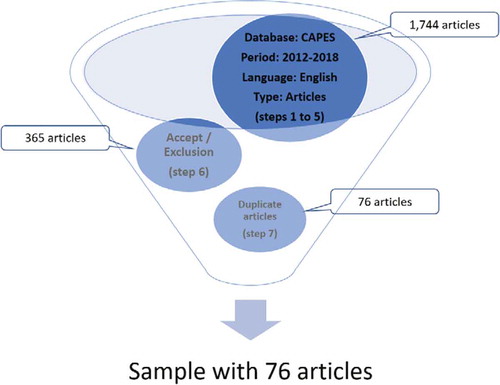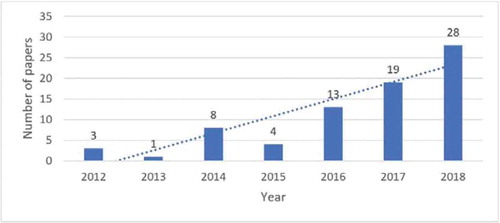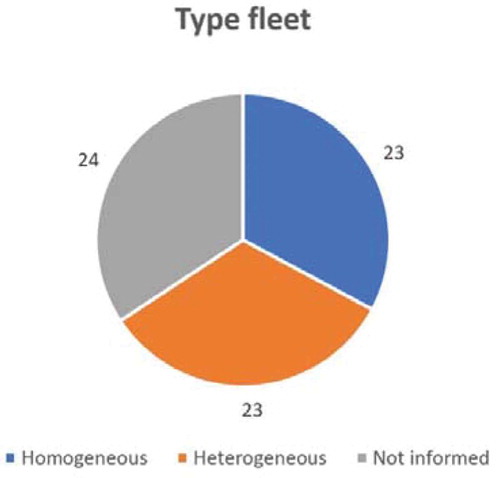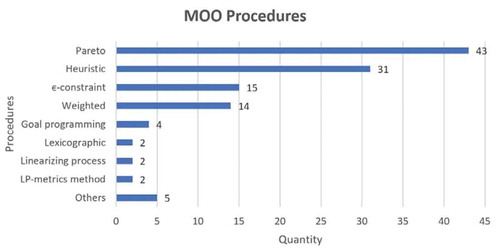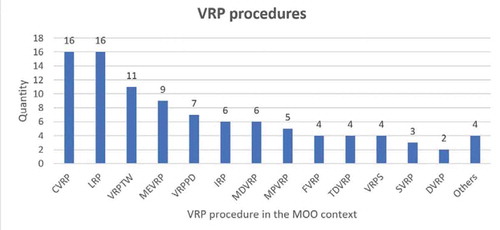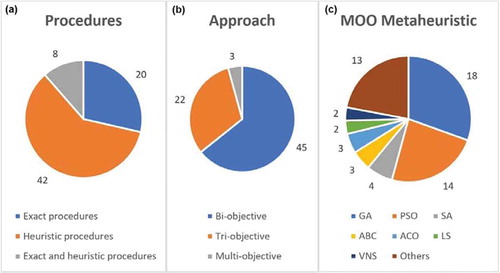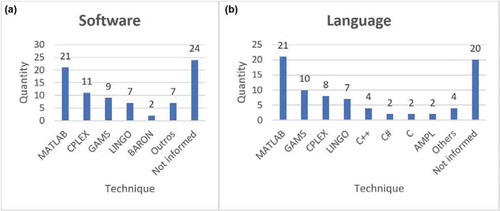 ?Mathematical formulae have been encoded as MathML and are displayed in this HTML version using MathJax in order to improve their display. Uncheck the box to turn MathJax off. This feature requires Javascript. Click on a formula to zoom.
?Mathematical formulae have been encoded as MathML and are displayed in this HTML version using MathJax in order to improve their display. Uncheck the box to turn MathJax off. This feature requires Javascript. Click on a formula to zoom.Abstract
This article aims to present research conducted on the literature regarding multi-objective optimization for routing problems with environmental considerations, referred to here as Multi-objective Optimization for the Green Vehicle Routing Problem (MOOGVRP). A Brazilian database, CAPES (Coordination for the Improvement of Higher Education Personnel), was used to collect articles of general application, case studies and reviews in English starting from, since 2012. The terms “green vehicle routing problem” (GVRP), “pollution routing problem” (PRP), “vehicle routing problem in reverse logistics” (VRPRL) and “multi-objective” were used in the research protocol. Consequently, this study obtained 1,744 research results that, following the application of the filtering criterion, resulted in a sample of 76 articles from 38 journals, for which a bibliometric data (bibliometric review) survey was conducted. The originality of this article lies in how the research is presented, highlighting the results and details obtained through the survey, which may be considered of great academic importance in the sense of guiding the trends for future research.
PUBLIC INTEREST STATEMENT
This article aims to present research conducted on the literature regarding multi-objective optimization for routing problems with environmental considerations. Here referred as Multi-objective Optimization for the Green Vehicle Routing Problem (MOOGVRP). Thus, through the bibliometric data we intend to present the directions for future research.
1. Introduction
In 2015, the UN (United Nations) proposed an agenda with 17 sustainable development goals to be implemented by all countries by the year 2030. The present study especially focuses on Goals 12 and 13 of this document. It addresses Goal 12 (Responsible consumption and production) by seeking an intelligent and optimized alternative to perform activities, and Goal 13 (Climate action) by seeking to reduce greenhouse gas emissions (ONUBR, 2015).
According to the report published by the United States Environmental Protection Agency (US EPA, Citation2018), the sources of greenhouse gas (GHG) emissions include five main sectors: Transportation; Electricity; Industry; Commercial and Residential; and Agriculture, as shown in Figure , which presents their respective percentages. In this study, the emphasis will be on the “share” related to Transportation (28.5%). Regarding this “share”, we found the following results: CO2 from Fossil Fuel Combustion (27.4%), Substitution of Ozone Depleting Substances (0.7%), Mobile Combustion (0.3%) and Non-Energy Use of Fuels (0.1%). Of these, this study will address the issues related to CO2 from Fossil Fuel Combustion and Mobile Combustion.
Figure 1. Emission sources according to the Inventory of US Greenhouse Gas Emissions and Sinks in 2016. Source:.US EPA (Citation2018)
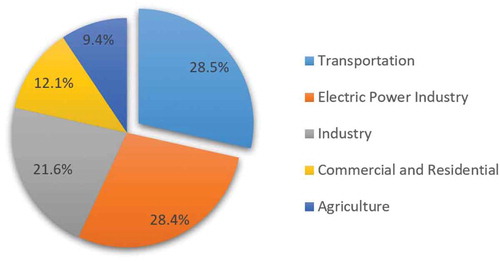
The Vehicle Routing Problem (VRP), proposed by Dantzing and Ramser (Citation1959), is highly significant for an efficient logistic distribution (Poonthalir & Nadarajan, Citation2018; Validi et al., Citation2015). The Green Vehicle Routing Problem (GVRP) directs routing activities through a perspective with environmental considerations (Toro et al., Citation2017a; Soleimani et al., Citation2018). Thus, a Multi-objective approach aids this process of complex decision-making in order to meet the objectives to be achieved (Ramos et al., Citation2014; Steiner et al., Citation2015; Steiner Neto et al., Citation2017).
In this context, we identified several works in the literature that address the optimization of fuel consumption (Abad et al., Citation2018; Poonthalir & Nadarajan, Citation2018), CO2 emission (Ebrahimi, Citation2018; Fathollahi-Fard et al., Citation2018), both cases simultaneously (Amer et al., Citation2016; Kumar et al., Citation2016) and other approaches (Fu et al., Citation2017; Ghezavati & Beigi, Citation2016) applied to the VRP.
In a complementary manner, the Triple Bottom Line of sustainability aids a real understanding of the application of Environmental Considerations to the VRP by addressing economic aspects through cost reductions, environmental considerations through GHG emissions and fuel consumption, and social considerations, such as work conditions and opportunities.
The aim of this study is to present research conducted on the literature regarding Multi-objective optimization (MOO) for vehicle routing problems with Environmental Considerations, referred to here as MOO for the Green Vehicle Routing Problem (MOOGVRP). Thus, this work aims to detect gaps in the literature for development and advances in this field of knowledge. This has been recognized as an important theme in a wide range of previous literature reviews, such as that of Demir et al. (Citation2014a).
The originality of this article lies in how the research is presented, showing the results and peculiarities obtained through the content analysis (systematic review), with the bibliometric data collection (bibliometric review) regarding the published articles related to the analyzed problem from 2012 to 2018.
The present work is organized as follows. After this introductory section, the methodological procedures are presented in Section 2. Section 3 contains a brief presentation of the Multi-objective approach (the VRP approach) and its variations, as well as the VRP with Environmental Considerations. In Section 4, the results are explained and discussed. The conclusions of the study are summarized in Section 5.
2. Methodological procedures
For the methodology of this research, the following steps were established as a search protocol (Figure shows the flowchart of the review process methodology of this research):
First, the timeline cut, covering the period between 2012 and 2018, in order to identify the recent discussions analyzed by academia;
Database selection: the study used the Brazilian database of CAPES (Coordination for Improvement of Higher Education Personnel), which gathers and makes available international scientific content for educational and research institutions in Brazil, composed of 38,000 journals, 532 reference databases including Cambridge Journals Online, Emerald Insight Emerald, IEEE Xplore, Scopus (Elsevier), Science Direct, SpringerLink, Taylor & Francis, as well as books, encyclopedias, technical standards, statistics and audiovisual content (Szejka et al., Citation2017);
The English language was adopted to select the articles;
Only journals (articles) were searched;
The keywords, as well as the logical operators used were: “green vehicle routing problem” OR “pollution routing problem” OR “vehicle routing problem in reverse logistics”, which were necessarily linked to “multiobjective” OR “multi-objective” OR “bi-objective”. The possible suffix variations in the terms used were also taken into account. The terms related to routing with Environmental Considerations were obtained from the literature review proposed by Lin et al. (Citation2014);
As an acceptance criterion, it was established that: (i) the research result should present the “green vehicle routing problem”, “pollution routing problem” or “vehicle routing problem in reverse logistics”, all of them being “multi-objective”. For this purpose, the titles and abstracts were assessed, as exemplified in Figure ; (ii) they could be literature “review”, “general” application (mathematical modeling and/or algorithm improvement articles), as well as “case” studies related to the proposed theme. As exclusion criteria, it was established that the results would be excluded if: (i) they were not related to the proposed theme; (ii) did not have full text available;
Remove duplicate articles.
From the protocol presented, we obtained 1,744 research results that, after the protocol filter, resulted in 76 articles for the research sample, from 38 journals. From this selection of articles, this study conducted a critical analysis of the research scope and sought to answer three questions:
1)What are the main discussions regarding MOOGVRP in recent surveys?
2)What are the most relevant studies regarding MOOGVRP?
3)What are the trends regarding MOOGVRP that may guide future research?
3. Theoretical framework
In this section, we briefly present the problems of MOO, the VRP and its variations, as well as the VRP with Environmental Considerations, which will be subdivided into the GVRP, Pollution Routing Problem (PRP) and Vehicle Routing Problem in Reverse Logistics (VRPRL).
3.1. Multi-objective optimization
MOO addresses the process of simultaneously optimizing two or more conflicting objectives subject to restrictions (Kumar et al., Citation2016; Steiner Neto et al., Citation2017). Its mathematical representation is presented using the objective function in EquationEq. (1)(1)
(1) and restrictions in (2–5).
where, x: vector of decision variables of dimension n; Z and f(x): correspond to the vector of the objective functions of dimension k; g(x): It is the set of inequality constraints of size m; h(x), the set of equality constraints of dimension p. In (1), the space Z = f(x) deals with the image of X, called feasible region in the space of objective functions. The restrictions presented in (2) and (3) define the space of the decision variables in Rn feasible region X and any point x ∊ X as a feasible solution. In (4) the domain of decision variables and, finally, in (5), the domain of objective functions (Ehrgott et al., Citation2012; Steiner et al., Citation2015).
MOO methods can be classified into generative methods and preference-based methods. The generative methods seek to generate one or more Pareto optimal points and can take into account the “non-use” for preferences, a scale approach or a multi-objective approach. The preference-based methods use information provided by the decision maker a priori or iteratively, as part of their solution process.
The classic methods commonly used for solving MOO problems can be organized into four categories. The first addresses the methods that do not articulate the given information of preference, such as the Method of Global Criterion. In the second one, we have a priori preferences, such as the Methods for Cardinal Information Given (Utility Function and Bounded Objective) and the Methods for Mixed Ordinal and Cardinal Information Given (Lexicographic Method and Goal Programing). In the third category, we have the methods for progressive articulation, most notably the Methods for Explicit Trade-Off Information Given (iterative methods) and implicit methods. Finally, we have a posteriori methods, among which we find the Parametric Method, є-constraint, Multi-objective Linear Programming and Adaptative Search (Demir et al., Citation2014a; Kumar et al., Citation2016).
According to Heilig et al. (Citation2017), the most frequently used Multi-objective techniques are: weighted sum scalarization, the є-constraint method, goal programming, lexicographic ordering and Pareto optimization. In relation to weighted sum scalarization, we must assign weights and treat the problem as a linear combination of established objectives. In the case of the є-constraint method, only one objective must be optimized, and the others must be considered as problem restrictions. In goal programming, the purpose is to meet all objectives, taking account of the goals established for each criterion. Lexicographic ordering considers an order of importance from the sequence in which the proposed objectives were listed. Finally, in Pareto optimization, an a posteriori approach provides the Pareto frontier with the intention of performing the trade-off of the solutions of the different objectives. According to Marler and Arora (Citation2004), the drawbacks of MOO are related to the complexity in developing the algorithms and usually require more computational effort than mono-objective techniques.
3.2. Vehicle routing problem
VRPs have many variations in the literature, and some of them are presented in Table (in alphabetical order), as proposed by Lin et al. (Citation2014) and Braekers et al. (Citation2016), followed by a brief description. It is worth mentioning that two or more of these variations can be combined, generating new variations for the VRP.
Table 1. Some VRP variations
3.3. VRP with environmental considerations
When addressing the VRP with Environmental Considerations, the classification proposed by Lin et al. (Citation2014) was used here, which sticks to the PRP, GVRP and VRPRL. The PRP search vehicle routing plan produces a lesser amount of pollution, in particular with a reduction in GHG and may include broader objectives that reflect the environmental cost. The GVRP considers the optimization of energy consumption in transport and reduction of fuel consumption. The objective of the VRPRL focuses on aspects of reverse logistics distribution. The latter category, VRPRL, can be divided into sub-categories: Selective Pickups with Pricing, Waste Collection, End-of-life Goods Collection and Simultaneous Distribution and Collection.
Selective Pickups with Pricing selects only profitable collection points to visit. Waste Collection (waste management) includes waste reuse, prevention and recycling. End-of-life Goods Collection is useful for remanufacturing. Finally, the Simultaneous Distribution and Collection addresses applied modeling in the context of reverse logistics (Demir et al., Citation2014b; Lin et al., Citation2014; Soleimani et al., Citation2018).
Additionally, Demir et al. (Citation2014a), in their review article, present, systematize and compare techniques for measuring GHG emission and fuel consumption applied to the road transportation of green loads.
Environmental Considerations can be addressed in one or more Objective Functions (OF) subject to restraints through mathematical modeling, be it a linear, non-linear, integer, mixed or dynamic programming model or other approach. In this study, emphasis will be placed on the OFs focusing on the environmental, social and economic contexts, reverse logistics, fuel consumption and CO2 emissions.
Thus, it can be said that many authors are concerned with minimizing costs, be they operational, general, financial or for transport (Abad et al., Citation2018; Govindan et al., Citation2017; S. Wang et al., Citation2018b) or maximizing revenues or profit (Niknamfar & Niaki, Citation2016; Zohal & Soleimani, Citation2016), as well as minimizing the number of vehicles (Y. Guo et al., Citation2017; Y. Wang et al., Citation2018a). Regarding the social aspect, a point in question is maximizing work opportunities (Ouhader & El Kyal, Citation2017), in addition to working hours (Ramos et al., Citation2014) and social responsibility (Govindan et al., Citation2016; Zhu & Hu, Citation2017). When it comes to reverse logistics, this is more difficult to measure, as not all problems found are clearly attributed to an OF, but rather to the consequent stratifications of its results (Farrokhi-Asl et al., Citation2018; H. Liu et al., Citation2012; Rabbani et al., Citation2016). On the other hand, GHG emissions and fuel consumption are easily measurable (Al-e-hashem et al., Citation2017; Androutsopoulos & Zografos, Citation2017; Demir et al., Citation2014a).
4. Results and discussion
In this section, we present the bibliometric data. This study identified information such as the quantity of publications per year, type of works published in the sample and percentage of journals that focus on sustainability (environmental, economic and social aspects). The study also shows the most frequently journals, countries and institutions that published the most works on the proposed theme, a frequency analysis of protocol terms in the title, abstracts and keywords and the relation between the taxonomies employed. Other information includes the relationship regarding the Triple Bottom Line, the fleets that are used and the most commonly used MOO procedures, VRP procedures, solution procedures, number of objectives and most frequently used metaheuristic methods. The software and programming languages for computational implementation and the frequency of the most used objectives were also identified. The study also includes the works related to the theme in question and a table summarizing the most frequently cited articles in the sample.
As presented in Section 2 (Methodology), this research sample was composed of 76 articles. Figure shows that the number of articles on the proposed theme has increased over the years. It should be highlighted that the sample of 76 articles was collected from 2012 to 2018.
Table shows the number of authors, article types and the journals on sustainability in the sample. Regarding the number of authors, the articles with two, three and four authors correspond to 65 papers in the sample, demonstrating the existence of research groups or works developed in academic environments. As the article types, the articles were classified as General (27 articles), Case studies (43 articles) and Reviews (6 articles). The journals on sustainability, as also shown was verified that only 10 of the 38 journals in the sample focus on issues related to sustainability (more specifically, they show interest in environmental aspects, sustainability, ecology, green manufacturing, the environment and related contexts). Where namely: Applied Energy, Computers & Operations Research, Decision Science Letters, Ecological Indicators, International Energy & Environment, Journal of Cleaner Production, Journal of Manufacturing Systems, Journal of Manufacturing Technology Management, Sustainability and Transportation Research Part D.
Table 2. Number of authors, article types and the journals on sustainability in the sample
Table shows the journals, institutions and countries that contributed to the MOOGVRP sample. They are organized by name and quantity. For the journals, it is worth noting that marked with (*) consider sustainability aspects, of which the Journal of Cleaner Production is the most used. For the institutions (institutions, research centers and companies with which the authors are associated), note that several articles cover more than one affiliation. We can particularly highlight three universities in Iran, Iran University of Science and Technology, Islamic Azad University and University of Tehran, with 6, 5 and 5 articles, respectively. The last subject of Table addresses the countries, it is worth noting that China and Iran contributed with 19 articles each. Figure presents the numerical frequency of the terms of the research protocol in the titles, abstracts, keywords and the three previous ones (All).
Table 3. Journals, Affiliations and Countries that have contributed to the MOOGVRP
Other journals: Annals of Operations Research, IEEE, Journal of Industrial Engineering International, Omega (United Kingdom), Operational Research, Sustainability* and Transportation Research Part C (2); Applied Computational Intelligence and Soft Computing, Applied Energy*, Applied Mathematics and Computation, Applied Soft Computing, Complexity, Computers & Operations Research*, Decision Science Letters*, Dyna, Ecological Indicators*, Energy Systems, Engineering Applications of Artificial Intelligence, Grey Systems: Theory and Application, International Energy & Environment*, International Journal of Advanced Research in Computer Science, International Journal of Industrial Engineering Computations, International Journal of Supply and Operations Management, Journal of Manufacturing Systems*, Journal of Manufacturing Technology Management*, Networks, Optimization Letters, Sensors, Transportation Research Part A and Transportation Research Part B (1).
Other affiliations: 2CRRC Zhuzhou Institute Co., Ltd.; Allame Tabataba’i University Business School; Arts et Metiers Paris Tech; Athens University of Economics and Business; Beijing Jiaotong University; Beijing University of Aeronautics and Astronautics; Canada Research Chair in Distribution Management, Interuniversity Research Centre on Enterprise Networks, Logistics, and Transportation; Chang’an University; Chung Yuan Christian University; Dalian Maritime University; Democritus University of Thrace; Dongbei University of Finance and Economics; Dublin City University; Dublin City University Business School; Ecole de Technologie Superieure; École Polytechnique de Montréal and GERAD; Erasmus University Rotterdam; ESC Rennes School of Business; Faculty of Economics and Business; Faculty of Engineering (Turkey); Fujian Agriculture and Forestry University; Fuzhou University; Grupo da Causa Humana; HEC Montréal; Hefei University of Technology; Huanggang Normal University; Hunan University of Science and Technology; Ibn Zohr University; IEAv—Institute for Advanced Studies; Indian Institute of Management; Indian Institute of Technology; Institución Universitaria CEIPA; Instituto de Pesquisa e Desenvolvimento de Tecnologias; Instituto Universitário de Lisboa; Isfahan University of Technology; Jeppesen Manager Government and Military Aviation; K. N. Toosi University; K. N. Toosi University of Technology; Karlsruher Institut für Technologie; Kharazmi University; KTH Royal Institute of Technology; Lancaster University Management School; Liverpool John Moores University; Luleå University of Technology; Missouri University of Science and Technology; Monash University Malaysia; Nagoya University; Nanyang Technological University; Narvik University College; National China University; National Institute of Industrial Engineering; North Carolina A&T State University; Petra Christian University; Pontificia Universidad Católica de Valparaíso; PSG College of Technology; Rayalaseema University; SK University; Shandong University of Finance and Economics; Shandong University of Science and Technology; Shanghai Jiao Tong University; Shanghai Maritime University; Sichuan University; Singapore Institute of Manufacturing Technology; Southwest Jiaotong University; Swinburne University of Technology; Tarbiat Modares University; Technical University of Crete; Technische Universität Dresden; The Arctic University of Norway; The Fuzhou University of Management; The Hong Kong Polytechnic University; The Southeast University of Economics and Management; The University of Auckland; UAE University; Universidad de San Buenaventura; Universidad Nacional de Colombia; Universidade de Lisboa; Universidade do Estado do Rio de Janeiro; Universidade Federal da Paraíba; Universidade Federal de Ouro Preto; Universidade Federal Fluminense; Universidade Nova de Lisboa; Università degli Studi di Modena e Reggio Emilia; Université de Lyon; Université Paris; Universiti Tunku Abdul Rahman; University of British; University of Connecticut; University of Delhi; University of East Anglia; University of Hamburg; University of Huddersfield; University of Memphis; University of New South Wales; University of Science and Technology of Mazandaran; University of Sheffield; University of Sussex; University of Vienna Oskar-Morgenstern-Platz; University of Wisconsin–Madison; Wageningen University; Wuchang University of Technology; Zhejiang Gongshang University; Zhejiang University of Technology and Zhongnan University of Economics and Law.
Other Countries: Germany, Ireland, Malaysia, Norway, Sweden and Taiwan (2); Belgium, Chile, Indonesia, Italy, Japan, Morocco, New Zealand, Portugal, Singapore, Turkey and the United Arab Emirates (1).
Figure 4. Frequency of the terms of the research protocol in the titles, abstracts and keywords of the 76 articles.
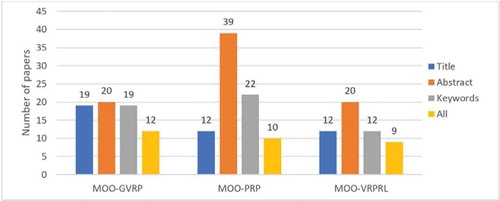
This relationship is made clearer in Figure ). This analysis is extremely important to the study because it is through these terms that the researchers achieved the sample for their works. It can be seen that the greater frequency of terms is concentrated in the abstract of articles and that there are few works that contain the search terms in the three fields.
Figure ) shows the relationship between the taxonomies of the VRP with Environmental Considerations presented here. We can observe (yellow circle on the left) that 12 articles in the sample address the MOO-GVRP (Abad et al., Citation2018; Androutsopoulos & Zografos, Citation2017; Coelho et al., Citation2017; Demir et al., Citation2014b; Hassanzadeh & Rasti-Barzoki, Citation2017; Norouzi et al., Citation2017; Poonthalir & Nadarajan, Citation2018; Psychas et al., Citation2016; Rani & Reddy, Citation2017; Rao et al., Citation2016; Rau et al., Citation2018; S. Wang et al., Citation2018b). Ten articles address the MOO-GVRP in conjunction with MOO-PRP (Khoo & Teoh, Citation2014; Amer et al., Citation2016; Baykasoğlu & Subulan, Citation2016; Niknamfar & Niaki, Citation2016; Kumar et al., 2017; Toro et al., Citation2017a, Citation2017b; Das & Jharkharia, Citation2018; Shui & Szeto, Citation2018; Rad & Nahavandi, Citation2018). Five articles address the MOO-GVRP in conjunction with the MOO-PRP and with the MOO-VRPRL (Farrokhi-Asl et al., Citation2018; Gupta et al., Citation2017; Lin et al., Citation2014; Malladi & Sowlati, Citation2018; Soleimani et al., Citation2018). Finally, one article addresses the MOO-GVRP together with the MOO-VRPRL (Gong et al., Citation2018). Thus, a total of 28 articles are related to the MOO-GVRP. Likewise, we can interpret the other circles (left and right). It should be highlighted that the goal of the GVRP is different from that of the PRP, since the objective of the former is to reduce fuel or energy consumption (or the battery, alternatively) and the latter seeks to minimize GHG emissions, mainly CO2. It was observed that in some articles the authors implicitly used their own taxonomy, as in Heilig et al. (Citation2017), Tricoire and Parragh (Citation2017), Fathollahi-Fard et al. (Citation2018), and X.-H. Liu et al. (Citation2018), generalizing the MOO-PRP as the MOO-GVRP. Furthermore, the opposite occurred in Demir et al. (Citation2014a), who referred to the MOO-GVRP as the MOO-PRP.
Figure 5. Representation of the research sample on VRP taxonomies with Environmental Considerations (a) and triple bottom line relationships (b).
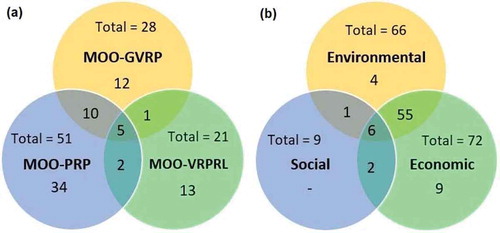
In Figure ), for the stratification of the pillars of the Triple Bottom Line, according to Dias (Citation2011), it was considered that for the economic dimensions, companies have to be economically feasible, in the sense of providing a return on investment. For the environmental dimension, companies should adapt to achieve ecoefficiency. In the social dimensions, companies should make changes such as providing better working conditions for their employees. In this context, articles will be categorized as economic when the OFs of their mathematical models are related to minimizing costs (general and/or operational, for instance), environmental when they seek to minimize GHG emissions and fuel, and social when they seek to improve working conditions for employees, for example, by increasing the number of jobs.
In this way, with Figure ), we can verify that most of the works are related to economic (costs) and environmental (GHG emission and fuel consumption) aspects. However, the lack of articles that address the social aspects indicates a good opportunity for advances in the literature. The same is true when trying to unite the three pillars in this context. For example, the article published by Y. Wang et al. (Citation2018a) was considered only economic in nature because the goals of its mathematical model sought to minimize costs and the number of vehicles. The work by Shui and Szeto (Citation2018) was considered only environmental in nature because the bi-objective problem involved GHG emissions and fuel consumption in the second OF, while the first OF was not related to the Triple Bottom Line. The article by Ouhader and El Kyal (Citation2017) was considered Triple Bottom Line (the link between social, economic and environmental) because the tri-objective problem sought to minimize costs, minimize GHG emissions and maximize social impacts through the creation of work opportunities in accordance with the capacities of the facilities.
Figures to 11 are related to articles classified as General and Case Studies (70 articles). The review articles (six articles) will not be considered in these figures because of their wide coverage. Figure shows the fleet classification (homogeneous or heterogeneous) through the sample articles.
Regarding the MOO procedures presented in Figure , we can verify the predominance of the Pareto to analyze the dominance or non-dominance of the obtained solutions. We then have the classification of the use of heuristic, є-constraint and weighted procedures. It is worth noting that several articles include more than one procedure.
Pareto Optimal is a complementary technique for multi-objective procedures, showing the better feasible solutions (options) in a graph for the decision maker. In this paper, it is used as part of the heuristic algorithm procedure or evaluate a population formed by the є-constraint method.
As for the VRP procedures shown in Figure , it must be taken into account that the same problem may contain more than one variant, in accordance with the works conducted by Ramos et al. (Citation2014), Ghezavati and Beigi (Citation2016), Govindan et al. (Citation2016), and Rabbani et al. (Citation2018). The Location Routing Problem (LRP) and the classical case (Capacitated VRP) were the most frequently used in the sample, followed by Time Windows, Multi-echelon, and Pickup and Delivery.
Legend: CVRP (Capacitated VRP), DVRP (Dynamic VRP), FVRP (Fuzzy VRP), IRP (Inventory Routing Problem), LRP (Location Routing Problem), MDVRP (Multi-depot VRP), MPVRP (Multi-period VRP), MEVRP (Multi-echelon VRP), SVRP (Scheduling in VRP), TDVRP (Time-dependent VRP), VRPPD (VRP with Pickup and Delivery), VRPS (VRP Stochastic) and VRPTW (VRP with Time Windows).
Figure ) presents the use and quantity of exact and heuristic procedures, or both, for the 70 articles. It should be noted that 43 (60%) of the articles only used heuristic procedures. Figure ) shows that 45 (64%) of the articles analyzed presented an approach with only two objectives and 22 (31%) are tri-objective. Figure ) shows the use proportion of heuristic procedures in the MOO context. We can observe that the techniques derived from population algorithms are predominant, where GA and PSO correspond to 54%.
Legend: ABC (Artificial Bee Colony), ACO (Ant Colony Optimization), CW (Clarke and Wright Heuristic), GA (Genetic Algorithm), LS (Local Search), PSO (Particle Swarm Optimization), SA (Simulated Annealing), VNS (Variable Neighborhood Search).
Figure presents the most frequently used software and the respective programming languages for the 70 articles. It should be mentioned that an article may have used more than one software or language, and that some software accepts different languages. Some authors reported only the software, others only the programming language, and there were some works lacking this information.
Legend: AMPL (A Mathematical Programming Language), CPLEX (Simplex method as implemented in the C programming language), GAMS (General Algebraic Modeling System), LINGO (Language for Interactive General Optimizer) and MATLAB (MATrix LABoratory).
Figure presents the main objective used in the 70 analyzed works. They were grouped into GVRP (Figure )), PRP (Figure )) and VRPRL (Figure 113(c)), with all of them being multi-objective. We can observe that all prioritize the minimization of costs among the main objectives. In the case of the GVRP, the minimization of fuel consumption is also among the main objectives. The same occurs with the PRP with CO2 minimization.
Figure 11. Most frequent objectives in MOO problems, applied to the GVRP (a), PRP (b) and VRPRL (c) in the 70 articles.
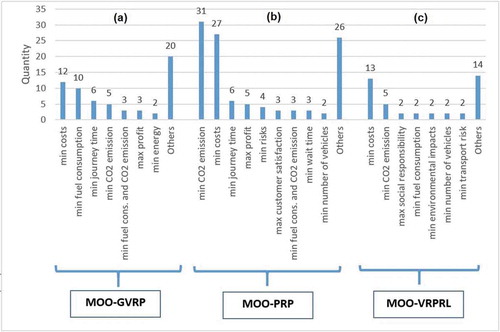
The most cited works in the sample are presented in Table . This table is structured by references, journals, article type and number of citations obtained through SCOPUS. A description of these works, listed according to their number of citations, is given below. In Appendix A we present brief reports of the sample of 76 articles in this study.
Table 4. The 11 most cited articles in the sample to MOOGVRP
The three most frequently cited works were literature reviews, conducted by Dekker et al. (Citation2012), Lin et al. (Citation2014), Demir et al. (Citation2014a), and Dekker et al. (Citation2012) proposed a contribution to the green logistic, promoting the integration of environmental aspects into the logistic. They addressed facilities, transport and inventory, considering the decision process through design, planning and control. Lin et al. (Citation2014) listed the main variations of the VRP, solution procedures (algorithms) and a proposed taxonomy for the VRP with environmental considerations (GVRP, PRP and VRPRL). A study on green road freight transportation was presented by Demir et al. (Citation2014a), making use of different ways to measure CO2 emissions and fuel consumption. They identified the criticality of factors to explain consumption, type of vehicle, freight, speed and road gradient, among others.
A case study addressing perishable food distribution was conducted by Govindan et al. (Citation2014). For this purpose, the authors used MOPSO, adapted multi-objective variable neighborhood search and the multi-objective hybrid approach, comparatively. Seeking to optimize fuel consumption and journey time, Demir et al. (Citation2014b) used the є-constraint together with the weighting method for the adaptive large neighborhood search algorithm, in addition to a hybrid method. With a view to obtaining a sustainable distribution by minimizing costs and CO2 emission for milk transportation in Ireland, Validi et al. (Citation2014) presented a mixed integer linear programming model and solved the problem through procedures derived from the GA: multi-objective GA of kind II (MOGA-II), NSGA-II (non-dominated sorting GA II) and a Hybrid combining GA and sequential quadratic programming.
Ramos et al. (Citation2014) resolved a case study on a recyclable waste collection system in Portugal, more specifically, in 19 rural municipalities. This reverse logistics problem was modeled as a multi-depot periodic vehicle routing problem with inter-depot routes, using the є-constraint technique to solve it. The authors wished to comply with the triple bottom line of sustainability, considering minimizing costs and CO2 emissions and maximizing working hours. Chen et al. (Citation2013) proposed a case involving a bi-objective model based on queues to reduce long lines of trucks at ports. The authors sought to minimize the number of truck arrivals and waiting time. For this purpose, they used the Pareto front GA-based heuristic and compared it with the NSGA-II. A fuzzy multi-objective model was proposed by Govindan et al. (Citation2016) to address the multi-echelon VRP and multi-period reverse logistics. The authors compared a PSO approach with the є-constraint. They applied the model to a case of medical syringe recycling for the purpose of minimizing costs and environmental impact and maximizing social responsibility.
Ehrgott et al. (Citation2012) presented a case study on the routing of bicycles in New Zealand, seeking to minimize journey time and maximize the adequacy of the routes that were used. Finally, Kumar et al. (Citation2016) presented production and PRP with Time Windows, in which they implemented the hybrid Self-Learning PSO. The authors sought to minimize costs and fuel consumption.
5. Final considerations and suggestions for future works
This study presented bibliometric data involving MOOGVRP from 2012 to 2018. This study adopted a protocol that resulted in 1,744 articles that, after a filtering definition, provided a sample of 76 articles from 38 journals. Its main contribution that it highlights the synergy between the VRP, MOO and the approach with Environmental Considerations, which is a relatively new trend that has grown in recent years. The bibliometric analysis was essential to understanding the profiles of published works.
The most relevant studies during the period in question were presented in Table , in which the three most frequently cited articles were reviews. Dekker et al. (Citation2012) and Demir et al. (Citation2014a) addressed aspects related to logistics, while Lin et al. (Citation2014) sought to demonstrate the evolution and relationship of the VRP with environmental considerations. The other most frequently cited articles sought to improve techniques and apply them to real contexts.
Appendix A summarized the proposal of the 76 articles focused on reviews, general application and case studies. The sample authors are associated with 96 institutions, research centers and companies, and the largest contributions, so far, have come from Iran, China, the US and the UK. Figure ) proved to be very interesting, as it shows the amount of work developed considering GVRP, PRP and VRPRL, as well as their interactions in the analyzed sample. In Figure ), this study conducted a similar analysis, taking into account the triple bottom line.
It was possible to verify the dominance of bi-objective models, which have been solved through heuristic, є-constraint and weighted procedures, with “a posteriori” Pareto optimization, based on GA and PSO. The most used VRP procedures in the analyzed sample were the LRP and CVRP. As shown in Figure , the main objectives addressed in the problems were to minimize costs, fuel consumption and CO2 emissions. There was great concern over improving the studies related to the reduction of GHG emission and the considerations of reverse logistics.
Many opportunities to explore applications and techniques related to MOOGVRP remain. We hope that the information presented here can aid those interested in their future research. Thus, by “going against the grain” of the most frequently researched themes, there is a great opportunity to make unprecedented contributions, of which the following may be mentioned:
Seeking heuristic procedures that have not often been used for multi-objective problems, duly adapted to the contexts in question, such as open, pickup time, multi-product and multi-modal (variations of the MOO-VRP least used in the sample of this study);
Although already widespread, seeking hybrid heuristic procedures to improve algorithms used in the context of the MOO-VRP;
Exploring applications that involve four or more objectives due to the serious lack of such applications in the literature;
Developing studies with large instances given the computational difficulty;
Presenting works that address the relationships between the MOO-GVRP, MOO-PRP and MOO-VRPRL or all of them simultaneously;
Researching better the social aspect of the Triple Bottom Line, addressing themes such as working hours, customer and/or employee satisfaction and risks in routes to be traveled.
Acknowledgements
This study was financed in part by PUCPR and the Coordination for the Improvement of Higher Education Personnel - Brazil (CAPES; 1st author); The National Council for Scientific and Technological Development – Brazil (CNPq; 2nd and 3rd authors) and Fundação Araucária (PRONEX-FA/CNPq 042/2018) for its financial support of this work.
Additional information
Funding
Notes on contributors
Júlio César Ferreira
Júlio César Ferreira Graduated in Industrial Engineering at Pontifícia Universidade Católica do Paraná (PUCPR), 2013; he got his master’s degree in Industrial and Systems Engineering Graduate Program (PPGEPS/PUCPR), 2016, in Operational Research area. He is currently a doctoral student at PPGEPS/PUCPR and has been working in Industrial Engineering Department at Unisociesc University Center of Curitiba, Paraná, Brazil.
Maria Teresinha Arns Steiner Postdoctoral at ITA (2005) and IST Lisbon (2014). She worked at Universidade Federal do Paraná (UFPR) from August 1978 to October 2010. Since February 2011, she has been working at PPGEPS/PUCPR. She has experience in Operational Research topics.
Osíris Canciglieri Junior Post-Doctoral at Loughborough University (LU), England, 2008. He is currently a professor and Director at PPGEPS/PUCPR. He has experience in Product Development Process and Green Supply Chain Management areas.
References
- Abad, H. K. E. A., Vahdani, B., Sharifi, M., & Etebari, F. (2018). A bi-objective model for pickup and delivery pollution-routing problem with integration and consolidation shipments in cross-docking system. Journal of Cleaner Production, 193, 784–33. https://doi.org/10.1016/j.jclepro.2018.05.046
- Al-e-hashem, S. M. J. M., Rekik, Y., & Hoseinhajlou, E. M. (2017). A hybrid L-shaped method to solve a bi-objective stochastic transshipment-enabled inventory routing problem. International Journal of Production Economics, 1–18.
- Alexiou, D., & Katsavounis, S. (2015). A multi-objective transportation routing problem. Operation Research, 15, 199–211.
- Amer, H., Salman, N., Hawes, M., Chaqfeh, M., Mihaylova, L., & Mayfield, M. (2016). An improved simulated annealing technique for enhanced mobility in smart cities. Sensors (Switzerland), 16(7), 1–23. https://doi.org/10.3390/s16071013
- Androutsopoulos, K. N., & Zografos, K. G. (2017). An integrated modelling approach for the bicriterion vehicle routing and scheduling problem with environmental considerations. Transportation Research Part C: Emerging Technologies, 82, 180–209. https://doi.org/10.1016/j.trc.2017.06.013
- Asadi, E., Habibi, F., Nickel, S., & Sahebi, H. (2018). A bi-objective stochastic location-inventory-routing model for microalgae-based biofuel supply chain. Applied Energy, 228, 2235–2261. https://doi.org/10.1016/j.apenergy.2018.07.067
- Baykasoğlu, A., & Subulan, K. (2016). A multi-objective sustainable load planning model for intermodal transportation networks with a real-life application. Transportation Research Part E: Logistics and Transportation Review, 95, 207–247. https://doi.org/10.1016/j.tre.2016.09.011
- Braekers, K., Ramaekers, K., & Van Nieuwenhuyse, I. (2016). The vehicle routing problem: State of the art classification and review. Computers & Industrial Engineering, 99, 300–313. https://doi.org/10.1016/j.cie.2015.12.007
- Chen, C., Qiu, R., & Hu, X. (2018). The location-routing problem with full truckloads in low-carbon supply chain network designing. Mathematical Problems in Engineering, 2018, 1–13.
- Chen, G., Govindan, K., & Golias, M. M. (2013). Reducing truck emissions at container terminals in a low carbon economy: Proposal of a queueing-based bi-objective model for optimizing truck arrival pattern. Transportation Research Part E: Logistics and Transportation Review, 55, 3–22. https://doi.org/10.1016/j.tre.2013.03.008
- Coelho, B. N., Coelho, V. N., Coelho, I. M., Ochi, L. S., Haghnazar, K., Zuidema, R., Lima, D., & da Costa, A. R. (2017). A multi-objective green UAV routing problem. Computers & Operations Research, 88, 306–315. https://doi.org/10.1016/j.cor.2017.04.011
- Conheça os novos 17 Objetivos de Desenvolvimento Sustentável da ONU. (2015, September 25). ONUBR. Retrieved February 15, 2019, from. https://nacoesunidas.org/conheca-os-novos-17-objetivos-de-desenvolvimento-sustentavel-da-onu/amp/.
- Costa, L., Lust, T., Kramer, R., & Subramanian, A. (2018). A two-phase Pareto local search heuristic for the bi-objective pollution-routing problem. Networks, 72(3), 311–336. https://doi.org/10.1002/net.21827
- Dantzing, G. B., & Ramser, J. H. (1959). The truck dispatching problem. Management Science, 6(1), 80–91. https://doi.org/10.1287/mnsc.6.1.80
- Das, C., & Jharkharia, S. (2018). Low carbon supply chain: A state-of-the-art literature review. Journal of Manufacturing Technology Management, 29, 398–428.
- Dekker, R., Bloemhof, J., & Mallidis, I. (2012). Operations Research for green logistics - An overview of aspects, issues, contributions and challenges. European Journal of Operational Research, 219(3), 671–679. https://doi.org/10.1016/j.ejor.2011.11.010
- Demir, E., Bektaş, T., & Laporte, G. (2014a). The bi-objective pollution-routing problem. European Journal of Operational Research, 232(3), 464–478. https://doi.org/10.1016/j.ejor.2013.08.002
- Demir, E., Bektaş, T., & Laporte, G. (2014b). A review of recent research on green road freight transportation. European Journal of Operational Research, 237(3), 775–793. https://doi.org/10.1016/j.ejor.2013.12.033
- Dias, R. (2011). Gestão Ambiental: Responsabilidade Social e Sustentabilidade (2ª ed.). São Paulo.
- Ebrahimi, S. B. (2018). A stochastic multi-objective location-allocation-routing problem for tire supply chain considering sustainability aspects and quantity discounts. Journal of Cleaner Production, 198, 704–720. https://doi.org/10.1016/j.jclepro.2018.07.059
- Ehrgott, M., Wang, J. Y. T., Raith, A., & Van Houtte, C. (2012). A bi-objective cyclist route choice model. Transportation Research Part A: Policy and Practice, 46(4), 652–663. https://doi.org/10.1016/j.tra.2011.11.015
- Entezaminia, A., Heydari, M., & Rahmani, D. (2016). A multi-objective model for multi-product multi-site aggregate production planning in a green supply chain: Considering collection and recycling centers. Journal of Manufacturing Systems, 40, 63–75. https://doi.org/10.1016/j.jmsy.2016.06.004
- Farrokhi-Asl, H., Makui, A., Jabbarzadeh, A., & Barzinpour, F. (2018). Solving a multi-objective sustainable waste collection problem considering a new collection network. Operational Research https://doi.org/10.1007/s12351-018-0415-0
- Fathollahi-Fard, A. M., Hajiaghaei-Keshteli, M. H.-K., & Tavakkoli-Moghaddam, R. (2018). A Bi-objective green home health care routing problem. Journal of Cleaner Production, 200, 423–443. https://doi.org/10.1016/j.jclepro.2018.07.258
- Fu, P., Li, H., Wang, X., Luo, J., Zhan, S. L., & Zuo, C. (2017). Multiobjective location model design based on government subsidy in the recycling of CDW. Mathematical Problems in Engineering, 2017, 1–9.
- Ghezavati, V. R., & Beigi, M. (2016). Solving a bi-objective mathematical model for location-routing problem with time windows in multi-echelon reverse logistics using metaheuristic procedure. Journal of Industrial Engineering International, 219(4), 469–483. https://doi.org/10.1007/s40092-016-0154-x
- Gong, X., Deng, Q., Gong, X., Zhang, L., Wang, H., & Xie, H. (2018). A bee evolutionary algorithm for multiobjective vehicle routing problem with simultaneous pickup and delivery. Mathematical Problems in Engineering, 2018, 1–21.
- Govindan, K., Darbari, J. D., Agarwal, V., & Jha, P. C. (2017). Fuzzy multi-objective approach for optimal selection of suppliers and transportation decisions in an eco-efficient closed loop supply chain network. Journal of Cleaner Production, 165, 1598–1619. https://doi.org/10.1016/j.jclepro.2017.06.180
- Govindan, K., Jafarian, A., Khodaverdi, R., & Devika, K. (2014). Two-echelon multiple-vehicle location-routing problem with time windows for optimization of sustainable supply chain network of perishable food. International Journal of Production Economics, 152, 9–28. https://doi.org/10.1016/j.ijpe.2013.12.028
- Govindan, K., Paam, P., & Abtahi, A. R. (2016). A fuzzy multi-objective optimization model for sustainable reverse logistics network design. Ecological Indicators, 67, 753–768. https://doi.org/10.1016/j.ecolind.2016.03.017
- Guo, Y., Cheng, J., Luo, S., & Gong, D. (2017). Robust Dynamic multi-objective vehicle routing optimization method. IEEE/ACM Transactions on Computational Biology and Bioinformatics, 5963, 1–13.
- Guo, Z., Zhang, D., Liu, H., He, Z., & Shi, L. (2018). Green transportation scheduling with pickup time and transport mode selections using a novel multi-objective memetic optimization approach. Transportation Research Part D: Transport and Environment, 60, 137–152. https://doi.org/10.1016/j.trd.2016.02.003
- Gupta, A., Heng, C. K., Ong, Y. S., Tan, P. S., & Zhang, A. N. (2017). A generic framework for multi-criteria decision support in eco-friendly urban logistics systems. Expert Systems with Applications, 71, 288–300. https://doi.org/10.1016/j.eswa.2016.09.033
- Hammad, A. W. A., Akbarnezhad, A., & Rey, D. (2017). Sustainable urban facility location: Minimising noise pollution and network congestion. Transportation Research Part E: Logistics and Transportation Review, 107, 38–59. https://doi.org/10.1016/j.tre.2017.09.005
- Hassanzadeh, A., & Rasti-Barzoki, M. (2017). Minimizing total resource consumption and total tardiness penalty in a resource allocation supply chain scheduling and vehicle routing problem. Applied Soft Computing, 58, 307–323. https://doi.org/10.1016/j.asoc.2017.05.010
- Heilig, L., Lalla-Ruiz, E., & Voß, S. (2017). Multi-objective inter-terminal truck routing. Transportation Research Part E: Logistics and Transportation Review, 106, 178–202. https://doi.org/10.1016/j.tre.2017.07.008
- Khoo, H. L., & Teoh, L. E. (2014). A bi-objective dynamic programming approach for airline green fleet planning. Transportation Research Part D: Transport and Environment, 33, 166–185. https://doi.org/10.1016/j.trd.2014.06.003
- Kumar, R. S., Kondapaneni, K., Dixit, V., Goswami, A., Thakur, L. S., & Tiwari, M. K. (2016). Multi-objective modeling of production and pollution routing problem with time window: A self-learning particle swarm optimization approach. Computers & Industrial Engineering, 99, 29–40. https://doi.org/10.1016/j.cie.2015.07.003
- Lin, C., Choy, K. L., Ho, G. T. S., Chung, S. H., & Lam, H. Y. (2014). Survey of green vehicle routing problem: Past and future trends. Expert Systems with Applications, 41(4), 1118–1138. https://doi.org/10.1016/j.eswa.2013.07.107
- Liu, H., Wang, W., & Zhang, Q. (2012). Multi-objective location-routing problem of reverse logistics based on GRA with entropy weight. Grey Systems: Theory and Application, 2(2), 249–258. https://doi.org/10.1108/20439371211260216
- Liu, X.-H., Shan, M.-Y., Zhang, R.-L., & Zhang, L.-H. (2018). Green vehicle routing optimization based on carbon emission and multiobjective hybrid quantum immune algorithm. Mathematical Problems in Engineering, 2018, 1–9.
- Long, J., Szeto, W. Y., & Huang, H. J. (2014). A bi-objective turning restriction design problem in urban road networks. European Journal of Operational Research, 237(2), 426–439. https://doi.org/10.1016/j.ejor.2014.01.053
- Malladi, K. T., & Sowlati, T. (2018). Sustainability aspects in Inventory Routing Problem: A review of new trends in the literature. Journal of Cleaner Production, 197, 804–814. https://doi.org/10.1016/j.jclepro.2018.06.224
- Marler, R. T., & Arora, J. S. (2004). Survey of multi-objective optimization methods for engineering. Structural and Multidisciplinary Optimization, 26(6), 369–395. https://doi.org/10.1007/s00158-003-0368-6
- Niknamfar, A. H., & Niaki, S. T. A. (2016). Fair profit contract for a carrier collaboration framework in a green hub network under soft time-windows: Dual lexicographic max-min approach. Transportation Research Part E: Logistics and Transportation Review, 91, 129–151. https://doi.org/10.1016/j.tre.2016.04.006
- Norouzi, N., Sadegh-Amalnick, M., & Tavakkoli-Moghaddam, R. (2017). Modified particle swarm optimization in a time-dependent vehicle routing problem: Minimizing fuel consumption. Optimization Letters, 11(1), 121–134. https://doi.org/10.1007/s11590-015-0996-y
- Ouhader, H., & El Kyal, M. (2017). Combining facility location and routing decisions in sustainable urban freight distribution under horizontal collaboration: how can shippers be benefited? Mathematical Problems in Engineering, 2017, 1–18. https://doi.org/10.1155/2017/8687515
- Pellicer, P. C., & Valero, F. A. (2018). Identification of reverse logistics decision types from mathematical models. Journal of Industrial Engineering and Management, 11, 239–249.
- Poonthalir, G., & Nadarajan, R. (2018). A fuel efficient green vehicle routing problem with varying speed constraint (F-GVRP). Expert Systems with Applications, 100, 131–144. https://doi.org/10.1016/j.eswa.2018.01.052
- Psychas, I. D., Marinaki, M., Marinakis, Y., & Migdalas, A. (2016). Non-dominated sorting differential evolution algorithm for the minimization of route based fuel consumption multiobjective vehicle routing problems. Energy Systems, 8(4), 785–814. https://doi.org/10.1007/s12667-016-0209-5
- Rabbani, M., Aghamohammadi Bosjin, S., Yazdanparast, R., & Akbarian Saravi, N. (2018). A stochastic time-dependent green capacitated vehicle routing and scheduling problem with time window, resiliency and reliability: A case study. Decision Science Letters, 7, 381–394. https://doi.org/10.5267/j.dsl.2018.2.002
- Rabbani, M., Farrokhi-Asl, H., & Asgarian, B. (2016). Solving a bi-objective location routing problem by a NSGA-II combined with clustering approach: Application in waste collection problem. Journal of Industrial Engineering International, 13(1), 13–27. https://doi.org/10.1007/s40092-016-0172-8
- Rabbani, M., Saravi, N. A., & Farrokhi-Asl, H. (2017). Design of a forward/reverse logistics network with environmental considerations. International Journal of Supply and Operations Management, 4, 115–132.
- Rad, R. S., & Nahavandi, N. (2018). A novel multi-objective optimization model for integrated problem of green closed loop supply chain network design and quantity discount. Journal of Cleaner Production, 196, 1549–1565. https://doi.org/10.1016/j.jclepro.2018.06.034
- Rahimi, M., Baboli, A., & Rekik, Y. (2017). Multi-objective inventory routing problem: A stochastic model to consider profit, service level and green criteria. Transportation Research Part E: Logistics and Transportation Review, 101, 59–83. https://doi.org/10.1016/j.tre.2017.03.001
- Ramos, T. R. P., Gomes, M. I., & Barbosa-Póvoa, A. P. (2014). Planning a sustainable reverse logistics system: Balancing costs with environmental and social concerns. Omega (United Kingdom), 48, 60–74.
- Rani, G. V., & Reddy, B. (2017). Multi-objective fuzzy shortest path selection for green routing and scheduling problems. International Journal of Advanced Research in Computer Science, 8(7), 470–475. https://doi.org/10.26483/ijarcs.v8i7.4267
- Rao, W., Liu, F., & Wang, S. (2016). An efficient two-objective hybrid local search algorithm for solving the fuel consumption vehicle routing problem. Applied Computational Intelligence and Soft Computing, 2016, 1–16. https://doi.org/10.1155/2016/3713918
- Rau, H., Budiman, S. D., & Widyadana, G. A. (2018). Optimization of the multi-objective green cyclical inventory routing problem using discrete multi-swarm PSO method. Transportation Research Part E: Logistics and Transportation Review, 120, 51–75. https://doi.org/10.1016/j.tre.2018.10.006
- Schaefer, B., & Konur, D. (2015). Economic and environmental considerations in a continuous review inventory control system with integrated transportation decisions. Transportation Research Part E: Logistics and Transportation Review, 80, 142–165. https://doi.org/10.1016/j.tre.2015.05.006
- Shui, C. S., & Szeto, W. Y. (2018). Dynamic green bike repositioning problem – A hybrid rolling horizon artificial bee colony algorithm approach. Transportation Research Part D: Transport and Environment, 60, 119–136. https://doi.org/10.1016/j.trd.2017.06.023
- Soleimani, H., Chaharlang, Y., & Ghaderi, H. (2018). Collection and distribution of returned-remanufactured products in a vehicle routing problem with pickup and delivery considering sustainable and green criteria. Journal of Cleaner Production, 8, 960–970. https://doi.org/10.1016/j.jclepro.2017.10.124
- Steiner, M. T. A., Datta, D., Steiner Neto, P. J., Scarpin, C. T., & Rui Figueira, J. (2015). Multi-objective optimization in partitioning the healthcare system of parana state in brazil. Omega (United Kingdom), 52, 53–64.
- Steiner Neto, P. J., Datta, D., Arns Steiner, M. T., Canciglieri Júnior, O., Figueira, J. R., Detro, S. P., & Scarpin, C. T. (2017). A multi-objective genetic algorithm based approach for location of grain silos in Paraná State of Brazil. Computers & Industrial Engineering, 111, 381–390. https://doi.org/10.1016/j.cie.2017.07.019
- Sun, Y., Hrušovský, M., Zhang, C., & Lang, M. (2018). A time-dependent fuzzy programming approach for the green multimodal routing problem with rail service capacity uncertainty and road traffic congestion. Complexity, 2018, 1–22.
- Szejka, A. L., Canciglieri, O., Panetto, H., Loures, E. R., & Aubry, A. (2017). Semantic interoperability for an integrated product development process: A systematic literature review. International Journal of Production Research, 55(22), 6691–6709. https://doi.org/10.1080/00207543.2017.1346314
- Teoh, B. E., Ponnambalam, S. G., & Subramanian, N. (2018). Data driven safe vehicle routing analytics: A differential evolution algorithm to reduce CO2 emissions and hazardous risks. Annals of Operations Research, 270(1–2), 515–538. https://doi.org/10.1007/s10479-016-2343-9
- Toro, E. M., Franco, J. F., Echeverri, M. G., & Guimarães, F. G. (2017a). A multi-objective model for the green capacitated location-routing problem considering environmental impact. Computers & Industrial Engineering, 110, 114–125. https://doi.org/10.1016/j.cie.2017.05.013
- Toro, E. M., Franco, J. F., Echeverri, M. G., Guimarães, F. G., & Gallego Rendón, R. A. (2017b). Green open location-routing problem considering economic and environmental costs. Int. J. Ind. Eng. Comput., 8, 203–216.
- Tricoire, F., & Parragh, S. N. (2017). Investing in logistics facilities today to reduce routing emissions tomorrow. Transportation Research Part B: Methodological, 103, 56–67. https://doi.org/10.1016/j.trb.2017.03.006
- US EPA (2018). Inventory of U.S. Greenhouse Gas Emissions and Sinks: 1990-2016. EPA 430-R-2018-003. Retrieved February 15, 2019, from https://www.epa.gov/sites/production/files/2018-01/documents/2018_complete_report.pdf.
- Validi, S., Bhattacharya, A., & Byrne, P. J. (2014). A case analysis of a sustainable food supply chain distribution system - A multi-objective approach. International Journal of Production Economics, 152, 71–87. https://doi.org/10.1016/j.ijpe.2014.02.003
- Validi, S., Bhattacharya, A., & Byrne, P. J. (2015). A solution method for a two-layer sustainable supply chain distribution model. Computers & Operations Research, 54, 204–217. https://doi.org/10.1016/j.cor.2014.06.015
- Validi, S., Bhattacharya, A., & Byrne, P. J. (2018). Sustainable distribution system design: A two-phase DoE-guided meta-heuristic solution approach for a three-echelon bi-objective AHP-integrated location-routing model. Annual Operation Research, 1–32.
- Van Engeland, J., Beliën, J., De Boeck, L., & De Jaeger, S. (2018). Literature review: Strategic network optimization models in waste reverse supply chains. Omega (United Kingdom). https://doi.org/10.1016/j.omega.2018.12.001
- Wang, S., Wang, X., Liu, X., & Yu, J. (2018b). A bi-objective vehicle-routing problem with soft time windows and multiple depots to minimize the total energy consumption and customer dissatisfaction. Sustain, 10, 1–21.
- Wang, Y., Peng, S., Assogba, K., Liu, Y., Wang, H., Xu, M., & Wang, Y. (2018a). Implementation of cooperation for recycling vehicle routing optimization in two-echelon reverse logistics networks. Sustain, 10, 1–27.
- Yang, B., Hu, Z. H., Wei, C., Li, S. Q., Zhao, L., & Jia, S. (2015). Routing with time-windows for multiple environmental vehicle types. Computers & Industrial Engineering, 89, 150–161. https://doi.org/10.1016/j.cie.2015.02.001
- Yin, P. Y., Lyu, S. R., & Chuang, Y. L. (2016). Cooperative coevolutionary approach for integrated vehicle routing and scheduling using cross-dock buffering. Engineering Applications of Artificial Intelligence, 52, 40–53. https://doi.org/10.1016/j.engappai.2016.02.006
- Yu, H., & Solvang, W. D. (2018). Incorporating flexible capacity in the planning of a multi-product multi-echelon sustainable reverse logistics network under uncertainty. Journal of Cleaner Production, 198, 285–303. https://doi.org/10.1016/j.jclepro.2018.07.019
- Yu, H., Solvang, W. D., & Li, S. (2015). Optimization of long-term performance of municipal solid waste management system: A bi-objective mathematical model. Int. J. Energy Environ., 6, 153–164.
- Zanghelini, G. M., Cherubini, E., & Soares, S. R. (2018). How Multi-Criteria Decision Analysis (MCDA) is aiding Life Cycle Assessment (LCA) in results interpretation. Journal of Cleaner Production, 172, 609–622. https://doi.org/10.1016/j.jclepro.2017.10.230
- Zapata-cortes, J. A., Arango-serna, M. D., & Serna-urán, C. A. (2018). Comparison of three IRP-based models to reduce logistics costs and greenhouse gas emissions. Dyna, 85(205), 199–204. https://doi.org/10.15446/dyna.v85n205.68282
- Zeng, W., Miwa, T., & Morikawa, T. (2016). Prediction of vehicle CO2emission and its application to eco-routing navigation. Transportation Research Part C: Emerging Technologies, 68, 194–214. https://doi.org/10.1016/j.trc.2016.04.007
- Zhang, B., Li, H., Li, S., & Peng, J. (2018). Sustainable multi-depot emergency facilities location-routing problem with uncertain information. Appl. Math. Comput., 333, 506–520.
- Zhu, L., & Hu, D. (2017). Sustainable Logistics Network Modeling for Enterprise Supply Chain. Math. Probl. Eng., 1–11.
- Zohal, M., & Soleimani, H. (2016). Developing an ant colony approach for green closed-loop supply chain network design: A case study in gold industry. Journal of Cleaner Production, 133, 314–337. https://doi.org/10.1016/j.jclepro.2016.05.091
Appendix A
A summary of the 76 articles related to MMGVRP is presented in Table . This Table is organized by references, presented in alphabetical and chronological order. The type of research of the articles was classified as a case study (c), general application (g) when the focus is on technique and literature review (r). The fleet of vehicle was classified as homogeneous (ho), heterogeneous (he) or not informed (ni). The VRP with EC was classified by the taxonomy used in this study: GVRP, PRP and VRPRL. It was determined whether the articles sought to meet the Triple Bottom Line requirements and whether the procedures used were exact, heuristic or, alternatively, both approaches. The number of objectives was organized as bi-objective (bi), tri-objective (tri) or multi-objective (multi). The desired outcomes of the study, the proposed application of the work, the solution techniques and number of citations were then specified (May 2018 through SCOPUS).
Table A1. Summary of the 76 articles related to MOOGVRP

